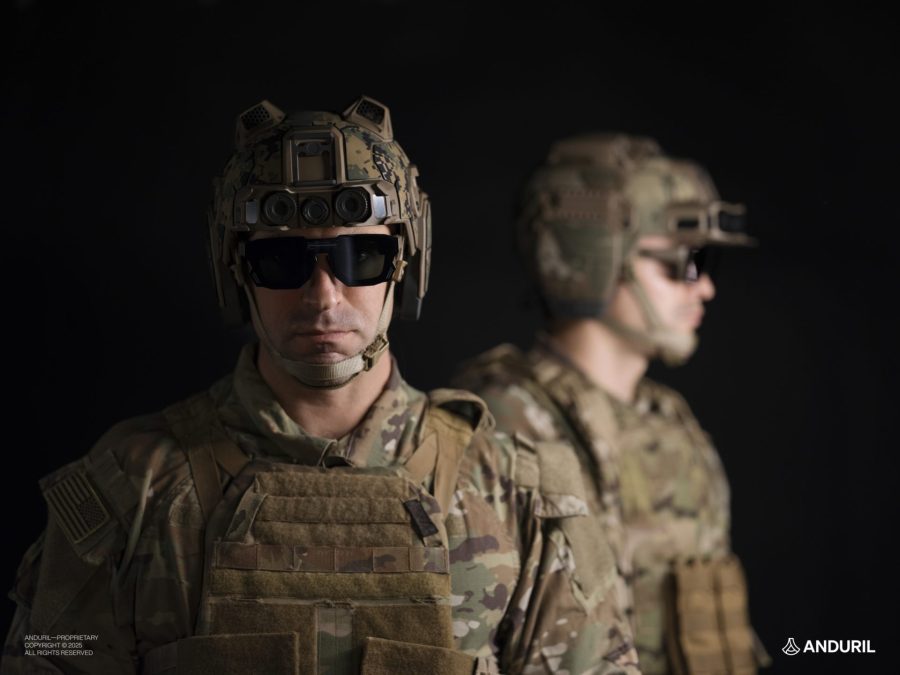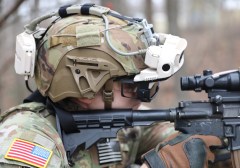Palmer Luckey previews Anduril’s new, AI-powered EagleEye headwear ahead of AUSA reveal

Anduril Industries will deliver roughly 100 units of its new AI-powered helmet and digitally-enhanced eyewear system — EagleEye — to select U.S. Army personnel during the second quarter of the upcoming calendar year, the company’s founder told reporters.
“We’re already in the production process for many of the components that are going into that,” Palmer Luckey said during a media roundtable he hosted at Anduril’s D.C. office to preview the tech ahead of a big reveal slated for Monday at the AUSA conference.
“This is an extremely powerful capability. It’s going to get cheaper and cheaper over time,” he said.
EagleEye’s launch has been a long time coming — both for the Army, and personally, for Luckey.
As a teenage wunderkind, he enjoyed experimenting with virtual reality designs in his parents’ garage. Luckey eventually developed the Oculus Rift prototype, and later sold it and his first company to Facebook for $2 billion in 2014, when he was in his early twenties. He was fired two years later, following backlash for making a political donation to a pro-Donald Trump group. Luckey pivoted and founded Anduril Industries to focus on solving national security problems with AI-enabling technologies.
Around that same time, the Army was moving to develop the ruggedized Integrated Visual Augmentation System (IVAS) to strengthen troops’ combat effectiveness and training options. In late 2018, the service awarded Microsoft an other transaction agreement (OTA) — worth up to $22 billion over 10 years — to produce the capabilities.
That work was plagued with challenges from the get-go, including issues with the system design and comfortability for soldiers who would need to wear it during dangerous operational scenarios. In April 2025, the Army approved a legal action that effectively transferred Microsoft’s contract for IVAS to Anduril.
“Not to sound too arrogant, but I knew. I knew that IVAS, as it was architected, was not going to work. I was very confident it was not going to work,” Luckey said. “I was, however, confident that at some point the military was going to realize this dream that’s been core to science fiction for decades, which is, we’re going to put a computer and a radio and a heads-up display on a soldier, and we’re going to do useful things with it — to keep him alive, to make him more lethal, everything in between — and we decided that we’re going to build the things that would allow us to be competitive in that area in the future.”
‘Rip them off’
The Army’s IVAS program ultimately evolved into the Army’s Soldier Borne Mission Command (SBMC) and Soldier Borne Mission Command–Architecture (SBMC-A) programs. While SBMC encompasses all the hardware and software for a soldier’s digital system, SBMC-A is essentially the open software platform that runs on that hardware.
In September, both Anduril and a company called Rivet were awarded separate contracts to build next-generation hardware for SBMC.
“But we’re the only people on the architecture contract,” or SBMC-A, Luckey noted. “Lattice is kind of the backbone of this, and it’s doing a better job than some of the things that were in it before.”
Anduril’s Lattice system is essentially a decentralized mesh networking capability that distributes data from various sources across services, domains, platforms, and long distances.
“Literally, nothing we’ve ever done has been something that was not exhaustively covered in science fiction. Even like Lattice — there’s so many systems that just are Lattice, like the exact descriptor. It’s like, ‘Oh yeah, it’s this AI brain that does all the system management and exists in a proliferated way across all these different systems,’” Luckey told reporters at the roundtable. “The point is, you’ll never come up with anything new when you’re in my industry. And so if you’re not going to come with anything new, you really need to go back and look at what people thought about it before — because they probably had some other ideas you should be ripping off too. Rip them off.”
He said it’s extremely important that the EagleEye “family of systems” is compatible with existing and emerging military technologies.
“I’m also a huge technician enthusiast myself. I want to be able to use my EagleEye helmet with all of my weirdo, wacky stuff,” Luckey noted.
He’s keen to build the capabilities needed to meet the military’s demands. But, what the tech founder envisions down the line, is a world where the EagleEye matures into a platform where dozens of providers can be simultaneously building things — including Anduril.
“Like, the guy who flies an Osprey [tiltrotor aircraft] probably should have a different system than a guy who is driving a tank. It’s just, not a little different — it’s a lot different. So that’s the way I look at this,” Luckey said.
He noted that this move away from one device for all users marks one of the most significant differences between Anduril’s and Microsoft’s approaches when producing and refining the devices. A few of Anduril’s earliest variants will be on display at the AUSA summit, he confirmed, including augmented reality glasses that the company is producing in collaboration with Oakley Sunglasses’ military business.
“In terms of what it feels like to use — it’s very different for everybody. Like, some people are going to be using an all-up integrated shell, where you’ve got thermal vision, night vision, a full ballistic face shield, protecting them from blast and frag. Other people are going to be wearing these glasses and a helmet that’s less configured, and not carrying all the stuff somebody doesn’t need,” Luckey told DefenseScoop. “And there’s going to be yet other people who are wearing just Oakley or other glasses. If I’m a guy working in a warehouse, or I’m like an aircraft maintainer, I don’t need all that other stuff. I just need something to do remote maintenance and repair and be able to stream stuff back home.”
The multiple variants will have modular add-ons and many common parts between them, such as compute chips and vision sensors. They’ll differ on more exotic pieces, like thermal and range capabilities. Some of the systems will be heavier and bulkier, and configurations will vary for nighttime and daytime use.
Those configurations include helmet, visor, and glasses. The systems are also designed to balance weight and keep sensors aligned with the wearer’s center of gravity.

Luckey noted that some of the prototypes can integrate with Army rifles, and they hold potential to help augment soldiers’ aiming processes.
“Has everyone read Starship Troopers? So like, Robert Heinlein came up with this stuff, literally, in like the 1940s. These are not new ideas. He said, ‘Oh, hey, you’ve got a ballistic computer on the rifle of the mobile infantry, and it tells you where the rounds are going to go given your motion, the relative motion, the target, the wind, and the Coriolis effect.’ So, we’re doing all that,” Luckey told reporters.
Notably, among the serious setbacks associated with Microsoft’s IVAS development, were persistent problems reported by soldiers about the devices being uncomfortable to wear — and causing many to suffer from “mission-affecting physical impairments” such as headaches, eyestrain and nausea.
“So, I don’t want to sound too arrogant here, but I have got this shit figured out. Like, I’ve done this before,” Luckey said. “I’ve done it more or less perfectly.”
He noted that cybersickness is a broad term to describe a variety of factors unique to AR and VR headsets that will make some people feel ill and vomit.
“If your eyes see something that disagrees with what your inner ear is measuring, then it will believe that you have been poisoned and that’s causing that mismatch, and that you need to expel the poison by vomiting. That’s the primary mechanism of cybersickness,” Luckey explained.
He expressed confidence that Anduril’s team has solved challenges associated with that mismatch, as well as others around latency, reprojection and calibration, which can also trigger physical discomfort from wearables.
“I guess going into this, I was not worried about the cybersickness problems, because I’ve kicked those problems’ butts. I kicked the butt of those problems before, and we’ve done it again,” Luckey said.
The entrepreneur added that he’s willing to acknowledge when he’s “being a little arrogant.”
“And I will recognize that is the case here. I do believe that I’m the world’s best overall head-mounted system designer, and so I am passionate about it. But I am also the best person to be doing this work. So, of other projects in Anduril — like, there’s a lot where that’s not the case,” Luckey told DefenseScoop.
Other customers
When Luckey was fired from Facebook — which is now known as Meta — early in his career, he quickly moved to pitch investors on a new plan to build tactical AR displays.
“One of my investors at the time told me that I could not put [all of] our eggs in that basket, because they believed that it was an extension of a pissing contest I had with Mark Zuckerberg as to how to build the best augmented reality glasses,” he said. “They were somewhat right.”
Years later, against a backdrop of mounting IVAS problems, he got the green light to create EagleEye.
Now, Meta is a key partner with Anduril on the platform. Luckey noted that the Facebook parent company is providing “some of the wave guide and display technology that they’ve spent billions of dollars developing.”
When asked if the Army’s originally set $22 billion contract ceiling still makes sense for the latest version of this overarching program, Luckey said that price estimate still holds “if they want it to be on the heads of every person who is going to end up in combat and are holding a rifle, shooting at people, and getting shot at.”
The service initially expected to pay $50,000 to $80,000 per unit under IVAS. Luckey noted that Anduril expects “to be coming in at half of that.” And in his view, commoditization by the consumer industry will eventually drive the cost per unit down to values in the low thousands.
“I strongly believe you are going to see augmented reality on every soldier’s head before you see it on every consumer’s head,” Luckey said.
Certain Army officials have already tested and experimented with working EagleEye prototypes, according to the entrepreneur. He pointed to training scenario use cases, including the command and control of drones and to launch loitering munitions.
The Army did not respond to DefenseScoop’s request for comment on Friday.
Looking to the future, Luckey noted that Anduril aims to market EagleEye to government entities beyond the U.S. military. “We will be working with other customers,” he noted, suggesting that there could be near-term applications for firefighters and other first responders.
The U.S. Department of Homeland Security is also a potential buyer, in Luckey’s eyes.
“We do a lot of work with various elements of DHS, both on the critical infrastructure security side with the U.S. Coast Guard, and also Border Patrol. So, I don’t know which of them is going to hit first. But there are definitely use cases. And we’re actively having those conversations. We’re prioritizing the Army first, because we just have to nail this and get this right,” Luckey told DefenseScoop. “And if we get this right for the Army, we should have a re-composable, modular system that’s very easy to tailor to their needs.”





